Discover 11 hidden attractions, cool sights, and unusual things to do in Gallipoli (Turkey). Don't miss out on these must-see attractions: Kilitbahir Castle, Lone Pine, and Helles Memorial. Also, be sure to include Plugge's Plateau in your itinerary.
Below, you can find the list of the most amazing places you should visit in Gallipoli (Çanakkale).
Table of Contents
Kilitbahir Castle
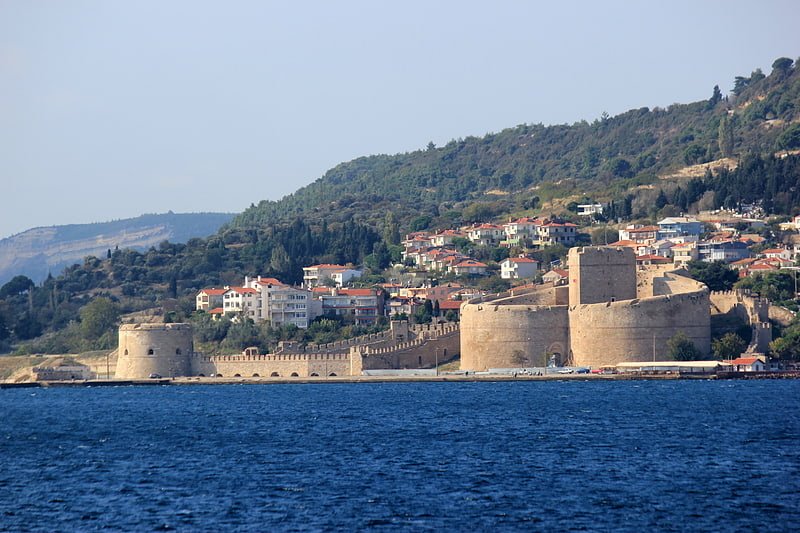
Also known as: Kilitbahir Kalesi
Castle in Kilitbahir, Turkey. Kilitbahir Castle is a fortress on the west side of the Dardanelles, opposite the city of Çanakkale, where there is a corresponding fortress, from which Çanakkale takes its name. The two castles were constructed by Fatih Sultan Mehmet in 1463 to control the straits at their narrowest point. Kilitbahir's name, meaning "lock of the sea", reflects this defensive purpose.[1]
Lone Pine

Cemetery. Lone Pine Cemetery is a Commonwealth War Graves Commission cemetery dating from World War I in the former Anzac sector of the Gallipoli Peninsula, Turkey and the location of the Lone Pine Memorial, one of five memorials on the peninsula which commemorate servicemen of the former British Empire killed in the campaign but who have no known grave.[2]
Helles Memorial
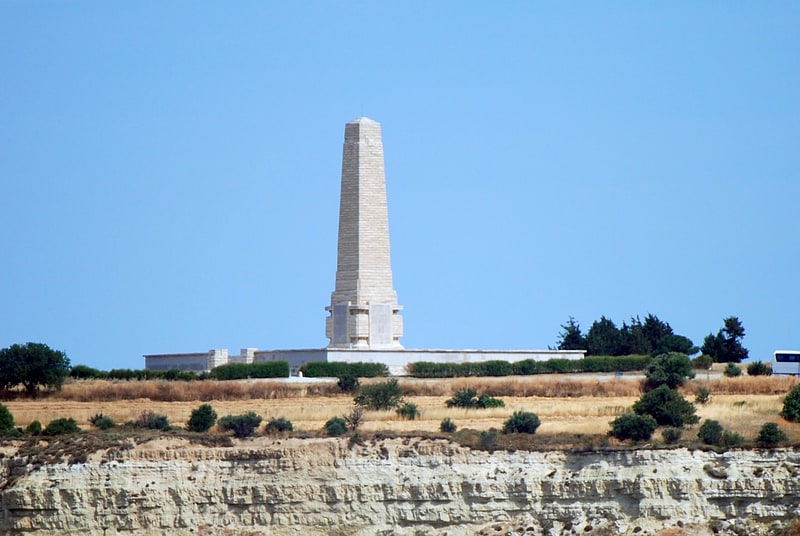
Monument in Turkey. The Helles Memorial is a Commonwealth War Graves Commission war memorial near Sedd el Bahr, in Turkey, on the headland at the tip of the Gallipoli peninsula overlooking the Dardanelles. It includes an obelisk which is over 30 metres high.
The memorial is the main Commonwealth battle memorial for the whole Gallipoli campaign, and also commemorates the 20,956 Commonwealth servicemen with no known grave who died in the campaign in 1915–1916, during the First World War.
The United Kingdom and Indian forces named on the memorial died in operations throughout the peninsula, with main landings at Cape Helles and Suvla Bay, and the Australian and New Zealand Army Corps fought mainly at ANZAC Cove. There are also panels for those who died or were buried at sea in Gallipoli waters.
Other Commonwealth memorials to missing servicemen from the Gallipoli campaign include the Lone Pine Memorial, Hill 60 Memorial, Chunuk Bair Memorial, and Twelve Tree Copse Memorial. Naval casualties who were buried at sea are also commemorated on the Portsmouth Naval Memorial, Plymouth Naval Memorial and Chatham Naval Memorial in the UK.
French casualties are commemorated at the Morto Bay French Cemetery. The main Turkish memorial is the Çanakkale Martyrs' Memorial.[3]
Plugge's Plateau

Cemetery in Turkey. Plugge's Plateau Cemetery is the smallest Commonwealth War Graves Commission cemetery on the Gallipoli Peninsula in Turkey. It contains some of soldiers killed during World War I during the battles at Gallipoli, was an eight-month campaign fought by Commonwealth and French forces against Turkish forces in an attempt to force Turkey out of the war, to relieve the deadlock of the Western Front and to open a supply route to Russia through the Dardanelles and the Black Sea.
Plugge's Plateau was located at the top of a steep 100 metre hill overlooking ANZAC Cove and Shrapnel Valley and was captured on 25 April 1915 shortly after the landing, by the 11th Battalion, 3rd Brigade of the AIF.
The plateau was later named by the invading troops after 37-year-old Lieutenant Colonel Arthur Plugge commanding officer of the Auckland Infantry Battalion of the New Zealand Expeditionary Force, who established his headquarters there.
It became a strongpoint within the ANZAC Inner Defence Line and the ANZAC headquarters were constructed lower down on the seaward side of the hill. An artillery position and a water reservoir were also sited on it. The Turkish forces named it Hain Tepe (Treacherous Hill) because of the effect of the artillery battery located on it. The cemetery is located on the North-West corner, and of the identified remains 12 are troops killed on the day of the landing and the rest are from nearby field artillery positions.[4]
V Beach
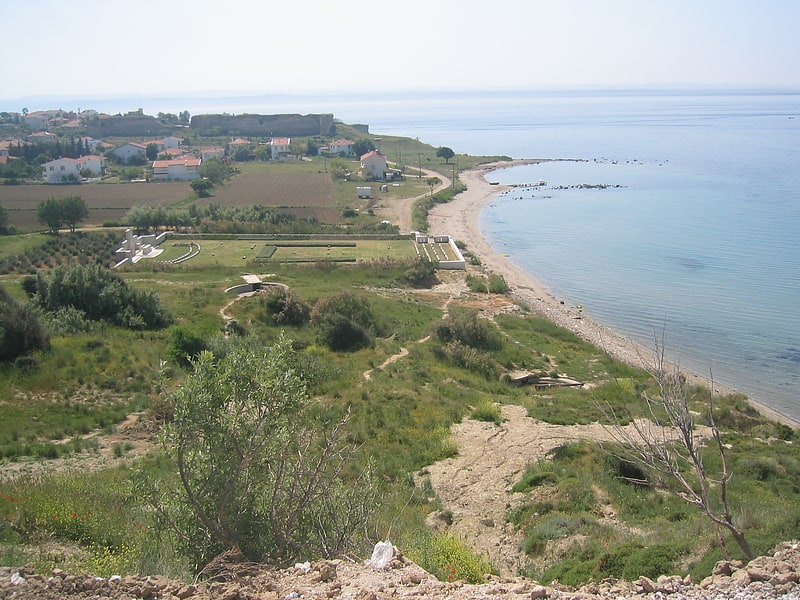
Cemetery in Turkey. V Beach Cemetery is a Commonwealth War Graves Commission cemetery located near Cape Helles, Gallipoli, Turkey.
The cemetery was brought into use shortly after the landing at Cape Helles at the end of April 1915 and its use ceased in May 1915. However 13 additional graves were moved into it in 1919 following the Armistice. As well as the 20 known graves, there are memorials to a further 196 soldiers and sailors who are known to be buried in the cemetery. In its overall capacity, the gravesite contains 696 soldiers who are buried at this site.[5]
The Nek Commonwealth War Graves Commission Cemetery
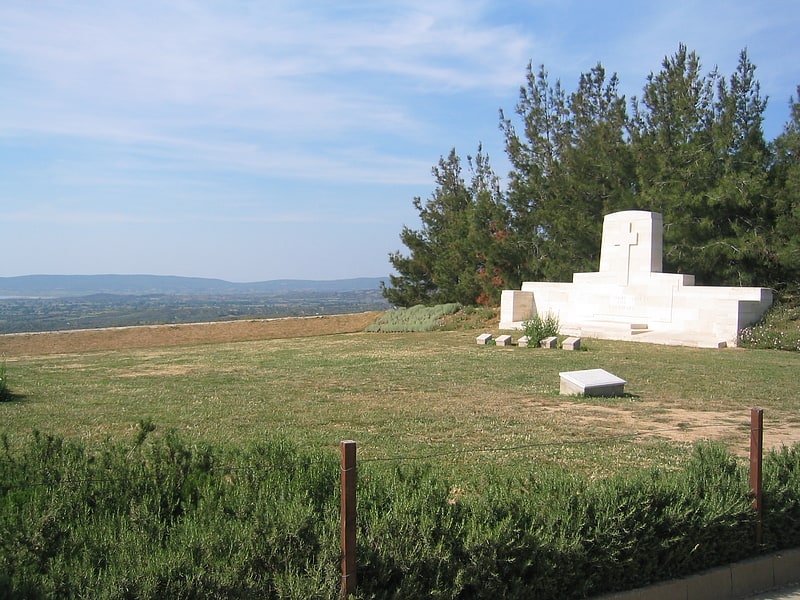
Cemetery in Turkey. The Nek Cemetery is a small Commonwealth War Graves Commission cemetery located near Suvla Bay on the Gallipoli Peninsula in Turkey.
The cemetery was constructed following the Armistice in 1919 on the site of the Battle of the Nek, at which time the ground was still covered with the remains of Australian 8th and 10th Light Horse troopers killed in the battle four years previously. It is likely that they form the majority of the unknown graves in the cemetery. The cemetery has the graves of only five identified soldiers and special memorials to another five known to be buried there.[6]
Lancashire Landing Commonwealth War Graves Commission Cemetery
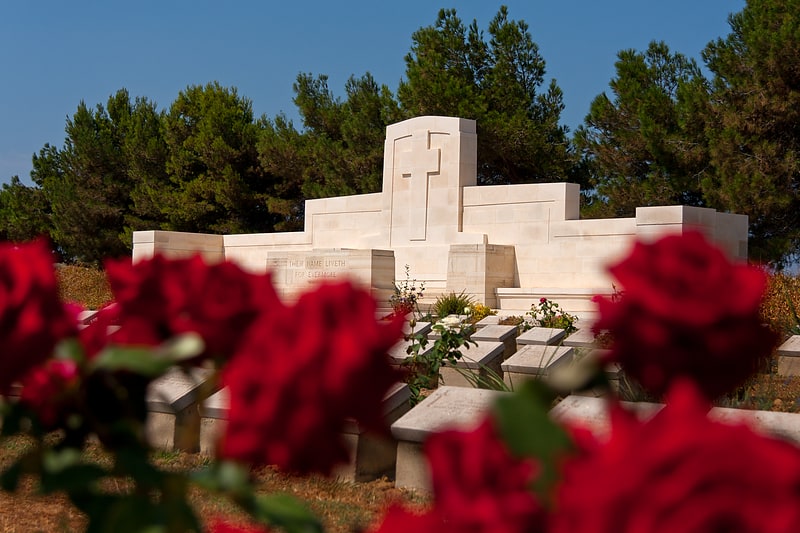
Cemetery in Turkey. Lancashire Landing Cemetery is a Commonwealth War Graves Commission cemetery located on the Gallipoli peninsula in Turkey. It contains the graves of some of the Allied troops killed during the Battle of Gallipoli.
It is located 500 metres inland from W Beach on Karaja Oghul Tepe (which the invading troops called Hill 114) just west of Cape Helles. Most of the cemetery was laid out between the landing in April 1915 and the evacuation in January 1916. Additional graves were moved into it from the Aegean islands after the Armistice.
Buried at the cemetery are Victoria Cross recipient, William Kenealy, two graves from the Zion Mule Corps, and 17 Greek graves. 135 of the burials are unidentified, but memorials commemorate ten of people known to be buried among them.[7]
Green Hill
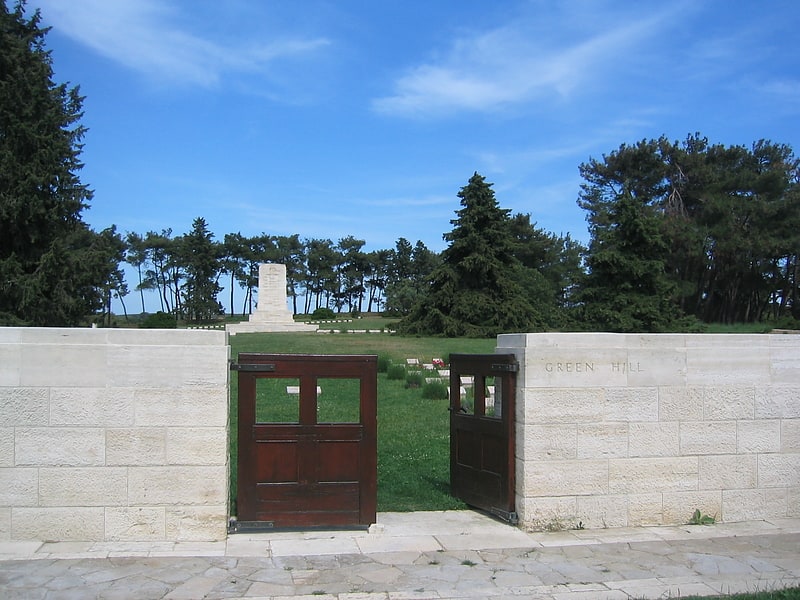
Cemetery in Turkey. Green Hill Cemetery is a Commonwealth War Graves Commission cemetery located near Suvla Bay, Gallipoli, Turkey.[8]
Hill 60 Commonwealth War Graves Commission Cemetery
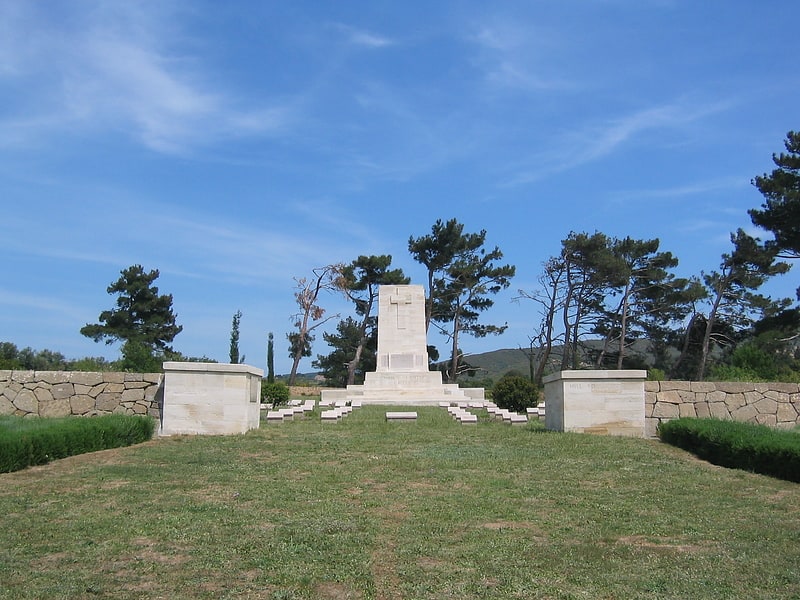
Cemetery in Turkey. Hill 60 Cemetery is a Commonwealth War Graves Commission cemetery dating from World War I at the Northern end of the former Anzac sector of the Gallipoli Peninsula, Turkey and the location of Hill 60 Memorial, one of four memorials on the peninsula which commemorate New Zealanders killed in the campaign but who have no known grave.
The battles at Gallipoli, some of whose participating soldiers are buried at this cemetery, was an eight-month campaign fought by Commonwealth and French forces against Turkish forces in an attempt to force Turkey out of the war, to relieve the deadlock of the Western Front (France/Belgium) and to open a supply route to Russia through the Dardanelles and the Black Sea.
The main landings were in April 1915, but failure to make any progress led to a further landing at Suvla Bay to the North of the existing Allied positions on 6 August. However indecision and confusion led delays allowing the Turkish defenders to reinforce their positions, resulting in a stalemate.
Hill 60 was a low Turkish occupied knoll 60 metres above sea level at the northern end of the Sari Bair range which nevertheless dominated the Allied positions near Suvla bay. It was the location of the Battle of Hill 60, the last major assault of the campaign, launched on 21 August 1915 to coincide with the attack on Scimitar Hill made from the Suvla front by General Stopford's British IX Corps. The battle lasted for 8 days, and although Australian troops reached the top of the hill the vital north facing slopes which overlooked Suvla remained in Turkish hands.
The cemetery, on the site of some of the trenches fought over during the battle, was used following the battle and extensively enlarged after the Armistice from remains found on the surrounding battlefield and from 42 graves moved in from Norfolk Trench Cemetery. 712 of the graves are unidentified, but special memorials commemorate 34 casualties thought to be amongst them.
The cemetery also contains one of four memorials commemorating New Zealand troops who do not have known graves, the Hill 60 (New Zealand) Memorial, and contains the names of 183 New Zealand soldiers killed during the battle. The cemetery also contains the identified graves of 13 New Zealanders (one of whom was in the Australian Imperial Force), and a further 16 are thought to be buried in the cemetery.[9]
Beach Commonwealth War Graves Commission Cemetery
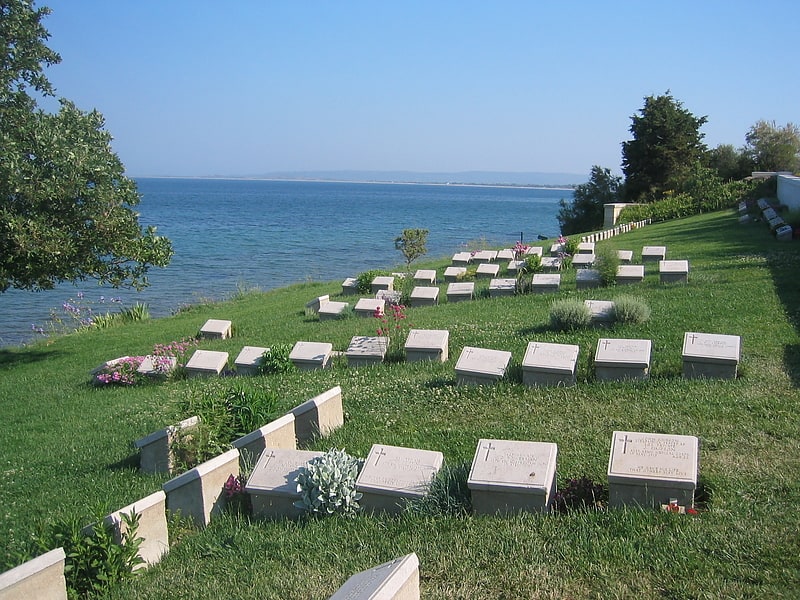
Cemetery in Turkey. Beach Cemetery is a small Commonwealth War Graves Commission cemetery containing the remains of allied troops who died during the Battle of Gallipoli. It is located at Hell Spit, at the southern end of Anzac Cove on the Gallipoli Peninsula.
The first graves were dug on the day of the landing 25 April 1915 and it continued to be used almost until the evacuation of the Anzac area on 20 December.
The majority of the graves, 285, are from the Australian Imperial Force, including that of Private John Simpson Kirkpatrick and three New Zealanders. It also contains 21 troops from the New Zealand army, 49 British personnel and three from the 80-strong Ceylon Tea Planters’ contingent. The tea planters were used as the Anzac commander, General William Birdwood's bodyguard. There are also 21 graves whose occupants are unknown.[10]
Quinn's Post Commonwealth War Graves Commission Cemetery
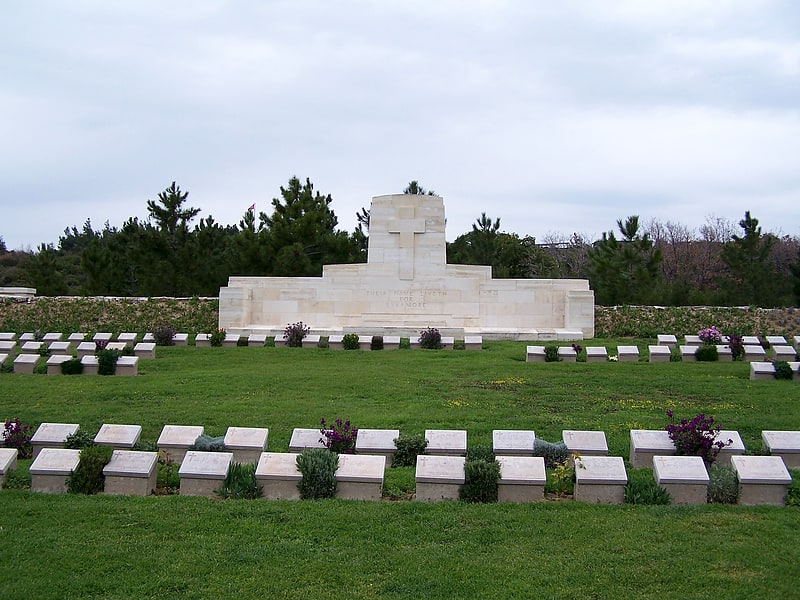
Cemetery in Turkey. Quinn's Post Cemetery is a Commonwealth War Graves Commission cemetery from World War I in the former Anzac sector of the Gallipoli Peninsula, Turkey. The battles at Gallipoli, some of whose participating soldiers are buried at this cemetery, were an eight-month campaign fought by Commonwealth and French forces against Turkish forces in an attempt to force Turkey out of the war, to relieve the deadlock of the Western Front and to open a supply route to Russia through the Dardanelles and the Black Sea.
Quinn's post was established on the day of the landing, 25 April 1915, as a New Zealand machine gun position and was taken over by Australian troops the following day. It was held by a variety of units until the evacuation of the Anzac sector and was the site of continual attacks and hand-to-hand fighting as Turkish troops defending the peninsula strove to recapture it. Fighting was intense, with heavy casualties on both sides, as it was a key position at the end of the Anzac line. It was overlooked by Turkish positions on three sides, and subjected to incessant sniper activity, and to grenade bombardment from Turkish positions only 15 metres away. The Turkish name for the position was Bomba Sirt (bomb ridge). Periscopes were used to survey the surrounding area, although they were prone to being damaged by rifle fire, and periscope rifles eventually allowed accurate fire to be directed towards the Turkish trenches. Wire nets were erected in front of the trenches to stop grenades. In his official history, the Australian historian, Charles Bean described the holding of the post as amongst the finest achievements of the Australian force.
It was named after Major Hugh Quinn, the 27-year-old commander of C Company, 15th Battalion, Australian Imperial Force. His detachment of 226 men took over the position from troops of the 14th Battalion on 29 April. Quinn was killed there on 29 May whilst reconnoitring for an attack to recapture trenches seized by the Turks earlier in the day and is buried in Shrapnel Valley Cemetery.
The cemetery was established after the war by moving 225 isolated graves into it, along with the 73 burials in Pope's Hill Cemetery and another six graves found together nearby. 105 Australian and 10 New Zealand graves belong to identified soldiers, and memorials record the names of 64 other soldiers thought to be buried in the cemetery.[11]